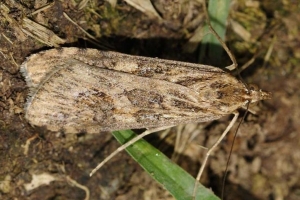1. Lebendfotos
1.1. Falter
2. Weitere Informationen
2.1. Faunistik
Karsholt & Razowski (1996) führten neben Nomophila noctuella unter Nummer 06720 Nomophila nearctica Munroe, 1973 an. In der Fauna Europaea [last update 27 january 2011, version 2.4] wird Nomophila nearctica nicht mehr erwähnt. Auf Hantsmoths [Nomophila nearctica auf Hantsmoths] wird kommentiert: „Vagrant/Accidental. Notes: Occurrence in the British Isles unconfirmed. This native of North America is included on the British list on the basis of a single specimen discovered in a collection in 1983 and said to have been taken either in Hampshire or Sussex. Wingspan 25-35mm. Very similar to Rush Veneer N. noctuella from which separated only by dissection of the genitalia. No evidence of breeding in the UK.” N. nearctica löst N. noctuella in Amerika ab (Verbreitung vom Norden des tropischen Südamerika bis nach Kanada). Wie bei N. noctuella in Europa kommt es auch dort zu Wanderbewegungen. Eine Verschleppung nach Europa ist grundsätzlich nicht völlig auszuschließen, ohne Genitalisierung aller Nomophila-Exemplare wäre sie aber gar nicht festzustellen. Festzuhalten bleibt daher, dass es für ein Vorkommen von Nomophila nearctica in Europa zumindest bislang keinerlei überzeugenden Hinweis gibt. Slamka (2013) akzeptiert die Fundmeldung aus England und sieht darin das Produkt einer Verschleppung mit Früchten.
Nach [Global Biodiversity Information Facility] kommt die Art in USA, Kanada, Mexico, Kolumbien und England vor.
Im Buch British & Irish Moths, Third Edition (2021), von Chris Manley steht: "One British record in 1919."
(Autor: Michel Kettner)
2.2. Typenmaterial
Munroe (1973: 192-194): “Holotype, male, Petite Rivière, N.S., 26 July 1935, J. McDunnough; allotype, female, Baddeck Forks, N.S., 22 July 1936, T. N. Freeman. [...] Holotype, allotype, and paratypes, Type No. 11,086, Canadian National Collection; paratypes in British Museum (Natural History), U.S. National Museum, American Museum of Natural History, Carnegie Museum, University of California, Berkeley, Califormia Academy of Sciences; Bavarian State Zoological Collection and Royal Ontaria Museum.” — 917 weitere Paratypen aus Kanada, den USA, Mexiko, Guatemala, den Bermudas und Haiti.
2.3. Literatur
- Erstbeschreibung: Munroe, E. (1973): A supposedly cosmopolitan insect: The celery webworm and allies, genus Nomophila Hübner (Lepidoptera: Pyralidae: Pyraustinae). — The Canadian Entomologist 105 (2): 177-216.
- Slamka, F. (2013): Pyraloidea of Europe (Lepidoptera). Volume 3. Pyraustinae & Spilomelinae. Identification - Distribution - Habitat - Biology. — 357 S., 133 Taf. mit Genitalabb., 31 Farbtaf. mit fast 1100 Bildern – Bratislava (Eigenverlag František Slamka).




![Einzelnachweis in Großbritannien [Agassiz, Beavan & Heckford (2013): Appendix A - Adventive Species]](/res/img/flag/gb.gif)
![Vorkommen in den Vereinigten Staaten von Amerika (USA) [Slamka (2013)]](/res/img/flag/us.gif)

![Vorkommen auf Grönland [Karsholt, Kristensen & Ahola (2015)]](/res/img/flag/gl.gif)
![Vorkommen in Mexiko [Slamka (2013)]](/res/img/flag/mx.gif)
![Vorkommen in Guatemala [Slamka (2013)]](/res/img/flag/gt.gif)
![Vorkommen in Costa Rica [Slamka (2013)]](/res/img/flag/cr.gif)
![Vorkommen in Bahamas [Slamka (2013)]](/res/img/flag/bs.gif)
![Vorkommen in Jamaika [Slamka (2013)]](/res/img/flag/jm.gif)
![Vorkommen in Haiti [Slamka (2013)]](/res/img/flag/ht.gif)

![Vorkommen in Bermuda (Britisches Überseegebiet) [Slamka (2013)]](/res/img/flag/bm.gif)

